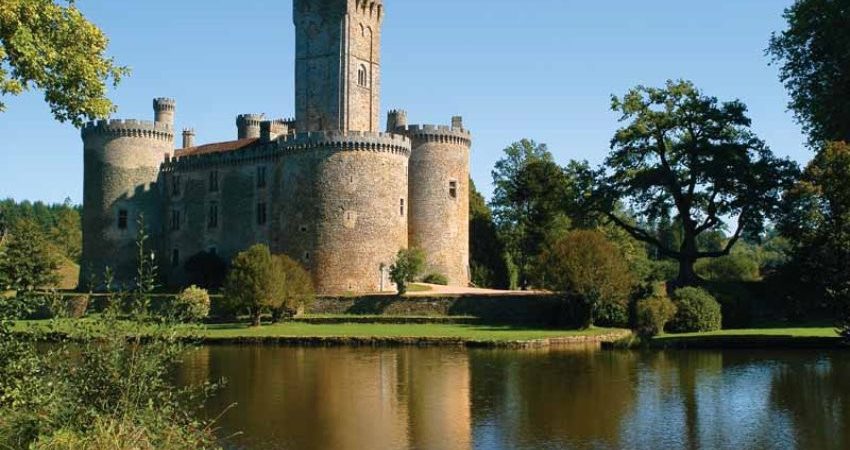Hill forts were only developed in Europe in the Bronze Age. However, their numbers rapidly increased during the Iron Age and for many years that followed. The larger defended settlements were named ‘oppidum’ (plural oppida), a Latin word that translates to the main settlement in any administrative area, deriving from the Latin ob-pedum that means enclosed space. The earliest known oppidum can be dated back to the Iron Age. In classical Latin, the castrum is a prehistoric enclosed site or fortress, better known as an encampment. A castrum referred to these large fortresses, whilst a smaller one was known as a castellum and this is how we came to know these impressive structures as castles.
Across Europe, in the 2nd century BC, many lived in these densely populated, fortified settlements on top of hills for defensive measures against possible invaders. The castle structures situated in these settlements were created with earthworks, rather than their stone counterparts, with palisades enclosing them for protection. The main features that made up these castles and surrounding settlements were the tall walls and gates, the vast expansion of area and the unspoilt view across the surrounding area. Castles were generally built onto higher, elevated grounds in order to show ownership of the surrounding areas, as well as for the obvious protective measure. However, not all were built with the purpose of protection, the development of castles and fortifications were a massive leap in the urbanisation of the whole continent, and are believed to be the first towns north of the Mediterranean.
The size and construction of these impressive fortifications varied tremendously across Europe. The oppida in Bohemia, a region in the western part of the Czech Republic and Bavaria, a state in the south-eastern part of Germany bordering Austria and the Czech Republic, were typically larger builds than those erected in the north and west of France. Whilst Britain sported smaller oppida, although some larger ones were evident in the south-east.
Characteristically, stone was used for the walls of the castles in central Europe, and these were supported by a bank of earth. To the east of Europe, timbers were sometimes used to support the ramparts, which is a defensive wall of a castle or city, and were known as the Preist type. Whilst to the west, a timber frame which was nailed together, known as the murus galicus, was the dominant feature of rampart design. In Britain, dump ramparts, consisting of earth that was supported by timber, were used and was a method later adopted by the French.
European castles can be separated into two, distinctive categories: those around the Mediterranean coast and the castles that were built inland. The ones that were established further inland were generally larger in size, see more variety in design and are spaced further apart from each other.
During the expansion of the Roman terrority through Northern Europe, the Romans discovered these hill forts. Although primitive in design, their effectiveness caught the attention of the Roman generals, who were only able to attain them through siege warfare techniques. The Romans had previously been creating ‘castras’, a simple temporary earthwork fortification that consisted of a protected plot of land or building.
The Gauls, who were tribes of Celtics that settled in France, Luxemburg, Belgium, Switzerland and Northern Italy, dominated most of Europe at the time and the oppidas that were there. Julius Caesar even pointed out a type of hierarchy between each Gaul tribe settlement, noting that there were several settlements but not all were of equal importance.
As the Romans began conquering several parts of Europe on their quest for world domination, they used the oppida infrastructure to decipher their importance and administer their empire, with many of the settlements becoming fully-fledged Roman towns.
Throughout the ages, the designs of these fortifications developed as skills advanced. The Normans, the name given to the people of Normandy during the 10th and 11th century AD, advanced the design of castles and forts. They preferred the traditional Motte and Bailey styles, but instead of building these structures with wood, they opted to construct everything using stone, and these remarkable buildings impress even to this day!
The classic motte and bailey were a fort that included a castle in an enclosed courtyard, surrounded by a wooden palisade and overlooked by the motte, a mound- either natural or artificial. Earth to create the artificial mounds was taken from ditches around the castle. Often, for double protection, another palisade and ditch were made, and were connected by a timber drawbridge which could be separated from the bailey in desperate measures to protect the people inside the castle during an invasion.
The Norman castles throughout France were built on high ground, often joined by rivers and overlooked the surrounding towns or harbours. They continued their designs throughout England of harsh looking stone structures in order to keep the English in line. The Normans often made use of the Roman or Saxon forts which made great places to set up camp. While in Italy, the Normans incorporated features of native Islamic, Lombard and Byzantine architecture into their own creations, and created the style known today as Sicilian Romanesque.
So, if you’re looking at castles for sale across Europe, be sure to enquire about the history of the property on your viewing.

I like the report